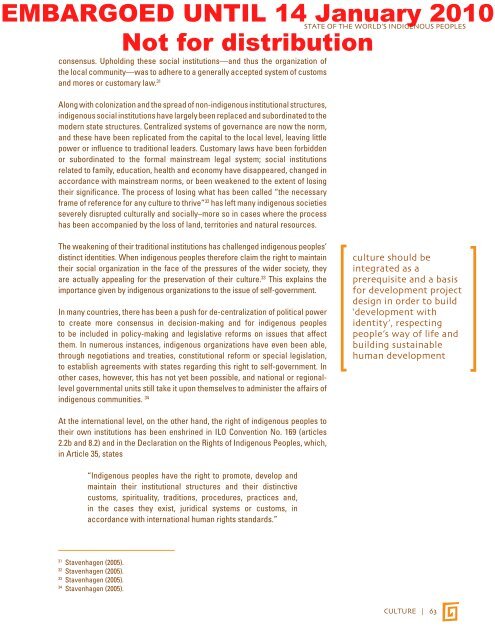STATE OF THE WORLD's INDIGENOUs PEOpLEs - CINU
STATE OF THE WORLD's INDIGENOUs PEOpLEs - CINU
STATE OF THE WORLD's INDIGENOUs PEOpLEs - CINU
- No tags were found...
Create successful ePaper yourself
Turn your PDF publications into a flip-book with our unique Google optimized e-Paper software.
EMBARGOED UNTIL 14 January 2010<strong>STATE</strong> <strong>OF</strong> <strong>THE</strong> WORLD’S INDIGENOUS PEOPLESNot for distributionconsensus. Upholding these social institutions—and thus the organization ofthe local community—was to adhere to a generally accepted system of customsand mores or customary law. 31Along with colonization and the spread of non-indigenous institutional structures,indigenous social institutions have largely been replaced and subordinated to themodern state structures. Centralized systems of governance are now the norm,and these have been replicated from the capital to the local level, leaving littlepower or influence to traditional leaders. Customary laws have been forbiddenor subordinated to the formal mainstream legal system; social institutionsrelated to family, education, health and economy have disappeared, changed inaccordance with mainstream norms, or been weakened to the extent of losingtheir significance. The process of losing what has been called “the necessaryframe of reference for any culture to thrive” 32 has left many indigenous societiesseverely disrupted culturally and socially–more so in cases where the processhas been accompanied by the loss of land, territories and natural resources.The weakening of their traditional institutions has challenged indigenous peoples’distinct identities. When indigenous peoples therefore claim the right to maintaintheir social organization in the face of the pressures of the wider society, theyare actually appealing for the preservation of their culture. 33 This explains theimportance given by indigenous organizations to the issue of self-government.In many countries, there has been a push for de-centralization of political powerto create more consensus in decision-making and for indigenous peoplesto be included in policy-making and legislative reforms on issues that affectthem. In numerous instances, indigenous organizations have even been able,through negotiations and treaties, constitutional reform or special legislation,to establish agreements with states regarding this right to self-government. Inother cases, however, this has not yet been possible, and national or regionallevelgovernmental units still take it upon themselves to administer the affairs ofindigenous communities. 34culture should beintegrated as aprerequisite and a basisfor development projectdesign in order to build‘development withidentity’, respectingpeople’s way of life andbuilding sustainablehuman developmentAt the international level, on the other hand, the right of indigenous peoples totheir own institutions has been enshrined in ILO Convention No. 169 (articles2.2b and 8.2) and in the Declaration on the Rights of Indigenous Peoples, which,in Article 35, states“Indigenous peoples have the right to promote, develop andmaintain their institutional structures and their distinctivecustoms, spirituality, traditions, procedures, practices and,in the cases they exist, juridical systems or customs, inaccordance with international human rights standards.”31Stavenhagen (2005).32Stavenhagen (2005).33Stavenhagen (2005).34Stavenhagen (2005).CULTURE | 63
















